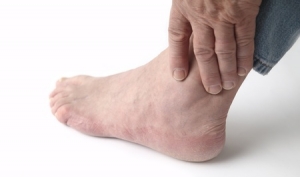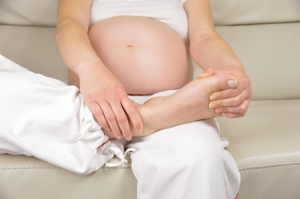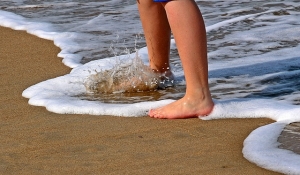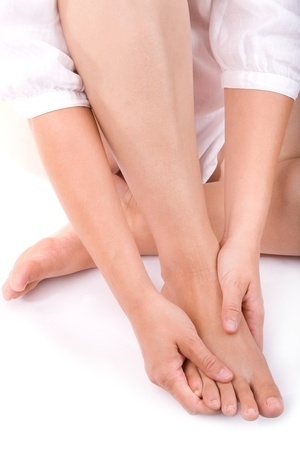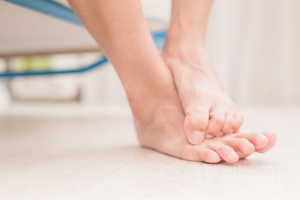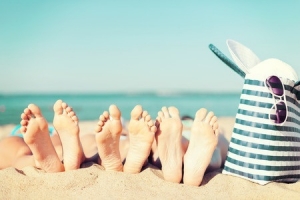Connect With Us
Blogs
Displaying items by tag: swelling
What’s Behind Swollen Feet and Ankles?
At Superior Foot & Ankle Care Center, we know that swelling of the feet and ankles is a fairly common occurrence. It can simply be the result of a long day spent sitting or standing without enough breaks to move around. Sometimes, however, swelling (also known as edema) can be the result of another issue going on in your body. For this reason, it’s important not to ignore swelling that lasts for more than a day or is an ongoing symptom. Contact our Long Beach office by calling: (562) 420-9800 to make an appointment with one of our podiatrists, Dr. Victoria M. Foley or Dr. Constance Ornelas to have your feet and ankles examined and find the source of the swelling.
Below are some common causes of edema:
Pregnancy—the fluids in your body greatly increase when you are pregnant. That fact, combined with the extra weight, it is normal to gain during pregnancy increase the likelihood of extra fluid pooling in the feet and ankles. Putting your feet up regularly is one of the best ways to prevent edema from causing discomfort.
Arthritis—when your joints become inflamed, it is not unusual for swelling to occur. You may notice pain and stiffness in the joints as well if arthritis is behind your edema.
Vein Problems—venous insufficiency can occur over time and is more common in patients over the age of 50. As the valves in veins get stretched out, they can begin to leak when the blood flows back to your heart. Thanks to gravity, the leaked blood will pool in the lower extremities. Another more serious vein issue that can have swelling as a symptom is a blood clot. If the swelling seems to be moving up your leg or the area is warm, you experience shortness of breath, or feel lightheaded, you should seek medical attention immediately.
Medical Conditions and Medications—edema can be a sign of an infection in a joint in your leg, ankle, or foot. It can also be a sign of lymphedema (a blockage in the lymphatic system that causes fluid to pool in the lower extremities), a heart, liver, or kidney problem. Anti-inflammatory medications (both prescription and over the counter), certain antidepressants, blood pressure medications, and hormones can all have edema as a side-effect.
Don’t delay in getting even mundane foot and ankle symptoms checked promptly. Contact us if you have any questions regarding the condition of your feet in Long Beach Douglas Park CA.
Avoid Foot Problems During Pregnancy
Are you pregnant? Congratulations! At Superior Foot & Ankle Care Center, we know how excited you must be. We also want to do our part to help ensure that your pregnancy proceeds as comfortably as possible. Hormonal changes and weight gain that occur naturally during pregnancy can play havoc on the health of your feet. Below are some common problems pregnant women encounter and what to do about them.
Arch and Heel Pain—these are perhaps the most common complaints pregnant women have about their feet. As your pregnancy progresses, the added weight can have the effect of flattening your arch, resulting in symptoms similar to those of patients with flat feet. Pain in the arch and heel pain due to the strain put on the plantar fascia (the long band of tissue that runs along the bottom of your foot) are not uncommon. To combat this type of discomfort, look for shoes with extra arch support. In some cases, our podiatrists, Dr. Victoria M. Foley or Dr. Constance Ornelas will fit you with a custom orthotic device to wear in your shoes.
Ingrown toenails—hormones released by your body toward the end of your pregnancy to help relax ligaments to make birth easier can affect your feet by causing them to spread. Your shoes may start to feel too tight. When toes are pressed up against each other for long periods of time, ingrown toenails can develop. It may be necessary to buy shoes that are a larger size or wider width for the last trimester.
Swelling—excess fluid in your body, and the position of the baby may result in swollen feet and ankles. This can lead to discomfort and pain. The best way to reduce swelling is by putting your feet up frequently. Stretching, not crossing your legs when sitting and drinking lots of water will help too.
If your feet are giving you trouble during your pregnancy, make an appointment at our Long Beach office in Douglas Park CA by calling: (562) 420-9800. Our podiatrists will help get to the source of your discomfort and prescribe a safe and effective treatment.
Helpful Hints for Hikers
Hiking is a great way to stay in shape, spend time with family and friends, and appreciate the beauty of nature. At Superior Foot & Ankle Care Center, we want our patients to keep their feet safe while enjoying this activity. Below are some recommendations before you hit the trail.
Shoe Sense—it all starts with the right hiking shoes or boots. The terrain on trails can be steep, uneven, and unstable. It’s essential that you have the proper foot gear. Get professionally fitted and buy quality-hiking shoes that protect your feet from moisture, provide good support and shock absorption, and have a tread to help prevent slips and slides. If you have chronic foot problem such as weak ankles or heel spurs, see our podiatrists, Dr. Victoria M. Foley or Dr. Constance Ornelas get recommendations for shoe styles and other modifications that will best accommodate your condition.
Proper Planning—if you are planning to hike on a trail you’ve never been on, study a map to determine the length of the trail, whether it’s “in and out” or a circle, the elevation, and how the trail is maintained. Take into consideration your current physical condition and don’t overdo it. Warm-up and stretch before starting a hike to avoid injuries like Achilles tendonitis.
Knapsack Know-How—in addition to granola bars and plenty of water (which will not only keep you hydrated but also reduce the chances of painful swelling in your feet and ankles), you should include a few other items in your backpack. Blisters, though small, can ruin a hike. Pack moleskin and use it as soon as you notice rubbing or a sore spot on your foot. It’s also a good idea to have wraps or elastic bandages in case of an ankle sprain and bandages and antibiotic ointment for minor scrapes or insect bites.
Foot and ankle injuries require immediate medical attention. If you fall, twist an ankle, or injure your feet or ankles in any way while hiking, contact our Long Beach office in Douglas Park, CA by calling (562) 420-9800 as soon as possible. Until you can get in to see us, follow the RICE regimen: Rest, Ice, Compression, and Elevation.
Beach Day or Bust?
At Superior Foot & Ankle Care Center, we know that many of our patients like to relax by spending a day at the beach. However, besides rain, nothing ruins a beach day faster than a foot or ankle injury. Below are some easy ways to avoid foot trouble and enjoy some fun in the surf and sand.
Watch out for Jellyfish—a dead jellyfish that has washed up on the shore through its tentacles can still sting you. If this happens, use gloves to protect your hands and gently remove the tentacles. Apply vinegar or baking soda to help the pain and swelling decrease.
Wear Flip Flops—this is one of the few times that you will hear us recommend flip-flops, but for a beach day, they can help your feet in several ways:
- Getting from the car to your beach blanket, they will prevent the soles of your feet from being burned by the hot asphalt or the sand that’s been baking in the sun.
- For walks on the beach, flip-flops can protect your feet from cuts from sharp shells and puncture wounds from debris hidden in the sand.
- When using the changing area or restroom, flip-flops will keep you from coming in contact with bacteria, viruses, and fungus that cause athlete’s foot, warts, and other
Re-Apply Sunscreen—a water-resistant sunscreen that has an SPF of 15 or higher should be used on the tops and bottoms of your feet if you are laying out on the beach. To be effective in preventing sunburn, it needs to be reapplied every two hours, and after each time you take a dip in the ocean.
Bring Sneakers—if beach volleyball, Frisbee or other active games are part of your idea of fun at the shore pack sneakers in your beach bag. Wearing flip-flops or playing barefoot can increase your risk for an ankle sprain in the shifting sands.
Remember Your Water Bottle—drinking lots of water is not only essential for staying hydrated, it helps you avoid swelling of the ankles and feet which can be painful and make it difficult to fit into your shoes for the ride home.
If your beach day results in an injury, rash or other foot or ankle symptoms, make an appointment at our Long Beach office (562-420-9800) promptly so that our podiatrists, Dr. Victoria M. Foley or Dr. Constance Ornelas can examine your feet and treat any podiatric problems.
5 Tips for Overworked Feet
Do you have an occupation that requires you to be on your feet for long hours at a time? At Superior Foot & Ankle Care Center we find that nurses, teachers, construction workers and other patients with jobs that have them upright and mobile for most of the day are more likely to have foot pain and swelling and are also at a higher risk for developing podiatric disorders. Although we can’t change your job, we can offer suggestions for ways to minimize foot pain and increase your comfort level.
Get Problems Checked Out Promptly
- The majority of foot problems, such as plantar fasciitis, sesamoiditis, flat feet and metatarsalgia, are made worse by being on your feet for extended periods of time. For this reason, if your work requires this, it’s particularly important to not put off getting foot problems evaluated. Our podiatrists, Dr. Victoria Foley and Dr. Constance Ornelas will examine your feet to determine the cause of your symptoms and recommend the best treatment. The foot doctor may be able to suggest padding or an orthotic device for your shoes to help relieve foot pain. Be sure to let the podiatrist know that you have a job that requires you to spend long hours on your feet.
Choose Shoes Wisely
- Your shoe choice is critical for comfort and protection. Choose styles with good ankle and arch support and a cushioned insole. It’s a good idea to alternate your shoes as well for maximum comfort and to avoid excess pressure to one particular spot on your foot.
Stay Hydrated
- Although it may seem backwards, drinking plenty of water is one of the best ways to prevent painful edema or swelling of your feet and ankles.
Make the Most of Break Time
- When you do get a break, get off your feet for as long as you can and elevate them if possible. Do some stretching exercises and flex your feet and toes. Once your break is over, try to change your position frequently. If you are unable to sit down, at least shift your weight from foot to foot.
Compensate During Non-Work Hours
- Be sure to put your feet up when you get home from work. Choose exercise and fitness activities that don’t put additional strain on your feet. Swimming, biking and rowing are examples of physical activities that don’t put more pressure on your feet. Be sure to soak your feet if they are sore and treat yourself to a foot massage now and then to relieve pain and stiff muscles.
If you have additional concerns about your feet and your occupation, contact our Long Beach office by calling: (562) 420-9800.
5 Foot Symptoms and What They Mean
At Superior Foot & Ankle Care Center, we urge all of our patients to inspect their feet regularly and report any unusual changes to our podiatrists, Dr. Victoria Foley or Dr. Constance Ornelas. Sometimes, however, we find out that patients put off making an appointment at our Long Beach office because the change they’ve noticed just doesn’t seem that serious. Small changes can mean big foot problems, and your feet can also act an “early warning system” for diseases that can affect your whole body. Below are some changes in your feet and what they may mean:
- Red skin. Although short-term redness of the feet could just be due to temperature change or an allergic reaction to your laundry detergent, consistent redness can mean something more serious. Infections, such as athlete’s foot, can start with redness of the skin and an itchy rash. Consistently red or inflamed feet can also be a sign of the autoimmune disease of lupus.
- Black toenail. Unless you’ve recently stubbed your toe or you’re a runner, a black or discolored toenail is characteristic of a fungal infection. These may not be painful initially but will continue to progress and are contagious if not treated.
- There are several diseases which can cause excess fluid buildup (also called edema) in your legs and feet. These include: kidney or liver failure, heart disease and diabetes. If you are pregnant, a certain amount of swelling is normal but if in the last trimester of your pregnancy you experience sudden or excessive swelling, it may be a sign of a preeclampsia, a serious condition that requires immediate treatment.
- Cold feet. If your feet are always cold, regardless of the season or temperature, it can be an indicator of poor circulation. There are several possible causes for this, including diabetes, anemia and an underactive thyroid.
- Everyone gets a foot cramp occasionally, but if you are getting them regularly, it’s something to get checked out. In some cases, it may simply be a case of dehydration or a lack of certain minerals in your diet like magnesium, potassium or calcium. On the other end of the spectrum, however, ongoing foot cramps can be an indicator of nerve damage.
If you notice anything different about your feet or ankles—even if the changes are not painful or dramatic—contact us as soon as possible at: (562) 420-9800.
5 Foot Friendly Vacation Tips
At Superior Foot & Ankle Care Center we’ve heard horror stories of summer vacations that patients never got to enjoy because they were sidelined by a foot problem early on in their trip. We’d like to help prevent podiatric mishaps when traveling and so we are offering these 4 tips for safer summer vacations:
- Wear comfy shoes on travel days. Whether you’re flying or taking a long road trip, you’ll want to start (and end) your trip with a comfortable pair of shoes, preferably ones with low heels and roomy toe boxes. Travel days can be strenuous—loading luggage, running to catch a flight, getting in and out of the car, are all best done in a pair of shoes that won’t hurt your feet or cause you to trip or fall. You will also want dependable shoes for walking and sports activities—save the heels and sandals for dinner out.
- Wear water shoes at the beach or lake. If there’s water in your vacation plans be sure to pack water shoes. Rocks, nails, glass, broken shells and washed up jellyfish and insects can be hidden in sand and mud and you can protect your feet from puncture wounds, cuts and stings by keeping them covered. Another good reason for water shoes (and this is true at a resort pool too) is that they prevent your feet from coming in contact with fungi and bacteria that lurk in warm, moist, public places. Nobody wants to bring home a case of athlete’s foot!
- Lather on the sunscreen. If the sun can get to your feet, your feet can end up sunburned. Badly burned feet can mean spending precious vacation days unable to walk. Apply sunscreen to the tops and bottoms of your feet when at the beach or pool. For sightseeing or shopping trips, if you’ll be wearing sandals put sunscreen on first, then your shoes.
- Drink lots of water. Edema, or swelling of the feet and ankles, can make walking painful. Staying hydrated helps to get rid of excess fluid and decreases swelling. Plus, it’s good for the rest of your body too!
- Add a few items to your pack list. They won’t take up much space but moleskin, some bandages and antibiotic ointment, extra socks and foot powder can make your days more comfortable.
If your summer vacation leaves you with any unwanted souvenirs such as an ankle injury, an unexplained rash or foot pain, contact our Long Beach office as soon as you return by calling: (562) 420-9800. Our podiatrists, Dr. Victoria Foley or Dr. Constance Omelas will help determine the cause of the problem and prescribe the right treatment to get you back to basking in the afterglow of your vacation.
